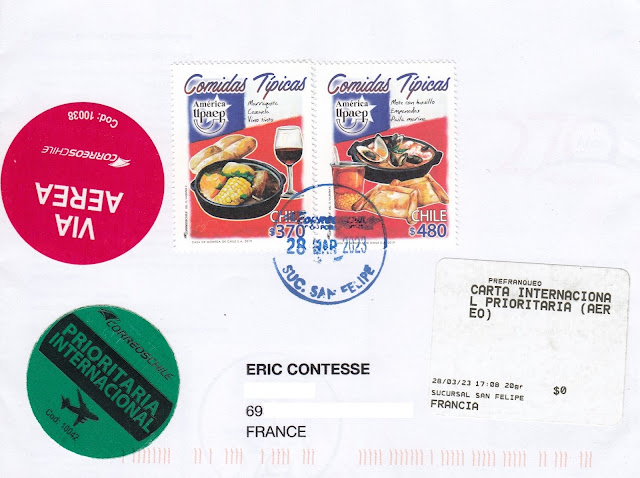Timbre "Vie souterraine cachée - lombric commun" sur FDC de Belgique
Nous nous demandons rarement ce qui vit dans le sol sous nos pieds. Or, cet univers est peuplé d'animaux, de champignons, de microbes et de plantes divers. Desquels nous sommes d'ailleurs dépendants.
Le 20 mars 2023 (vente Premier Jour à Bruxelles), la poste belge bpost a mis en circulation un intéressant feuillet intitulé "Vie souterraine cachée" composé de 5 timbres consacrés à des petits animaux très répandus dans notre environnement, mais auxquels nous ne prêtons jamais vraiment attention : lithobie à pinces (Lithobius forficatus), ver de terre commun (Lumbricus terrestris), perce-oreille (Forficula auricularia), porcellion rude (Porcellio scaber) et fourmi rouge (Myrmica rubra).
Un
de ces 5 timbres au tarif permanent domestique "2" (envoi non
normalisé NON PRIOR
entre 0 et 100g, 2,72€ actuellement) figure sur cette lettre avec TAD de Malines (Mechelen), appliqué ici avec une encre verte inhabituelle,
où avait lieu la prévente de ce feuillet le 18 mars 2023. Merci
beaucoup
Johan !
We rarely wonder what lives in the ground beneath our feet. However, this universe is populated by various animals, fungi, microbes and plants. On which we are moreover dependent.
On March 20, 2023 (First Day of issue in Brussels), the Belgian Post bpost put into circulation an interesting sheetlet entitled "Hidden underground life" composed of 5 stamps dedicated to small animals, very widespread in our environment, but to which we never lend really watch out: brown centipede (Lithobius forficatus), common earthworm (Lumbricus terrestris), common earwig (Forficula auricularia), common rough woodlouse (Porcellio scaber) and European fire ant (Myrmica rubra).
One of these 5 stamps at the domestic permanent rate "2" (not standardized NON PRIOR shipment between 0 and 100g, € 2.72 currently) was used on this cover with postmark from Mechelen, applied here with an unusual green ink, where the preview sale of this sheetlet took place on March 18, 2023. Thank you very much Johan!
Ce feuillet (tirage : 40604) a été conçu par l'illustrateur scientifique Sven Bellanger, avec une forme plissée spéciale. Plié, on voit une coupe transversale de la végétation au sol et de la terre en dessous. Lorsque le feuillet est déplié, les timbres apparaissent.
Le timbre ci-dessus est consacré au ver de terre commun (Lumbricus terrestris), une espèce qui joue un rôle essentiel dans notre écosystème. Le ver de terre commun est en effet apprécié par les jardiniers car il permet à l'air et à l'eau de circuler dans les nombreuses galeries souterraines qu'il creuse, ce procédé étant bénéfique pour le maintien des sols, pour la flore et pour l'écosystème en général.
Cette espèce, capturée par plusieurs espèces de batraciens et de mammifères de surface (taupe, musaraigne, blaireau, renard), de couleuvres ainsi que d'oiseaux, se nourrit de la matière organique en décomposition et des bactéries du sol. Les excréments rejetés donnent le compost utilisé comme engrais pour le sol.
This sheetlet (print run: 40,604) was designed by scientific illustrator Sven Bellanger, with a special pleated shape. Folded, we see a cross section of the vegetation on the ground and the earth below. When the sheetlet is unfolded, the stamps appear.
The stamp above is dedicated to the common earthworm (Lumbricus terrestris), a species that plays an essential role in our ecosystem. The common earthworm is indeed appreciated by gardeners because it allows air and water to circulate in the many underground galleries it digs, this process being beneficial for the maintenance of the soil, for the flora and for the ecosystem in general.
This species, captured by several species of batrachians and surface mammals (mole, shrew, badger, fox), grass snakes and birds, feeds on decomposing organic matter and soil bacteria. Discarded excrement yields compost used as soil fertilizer.
























